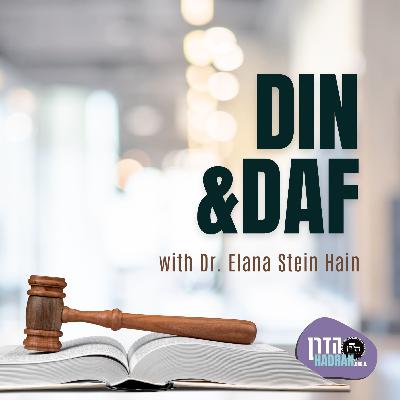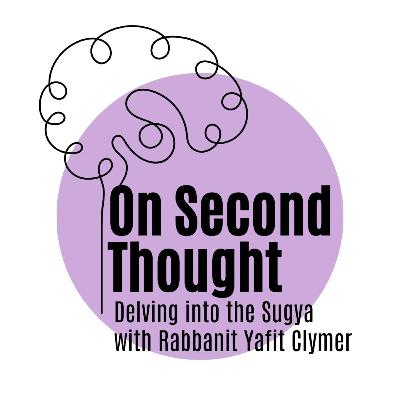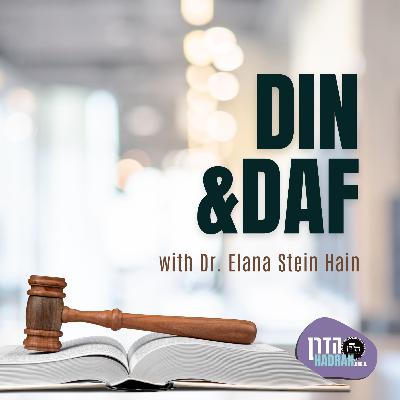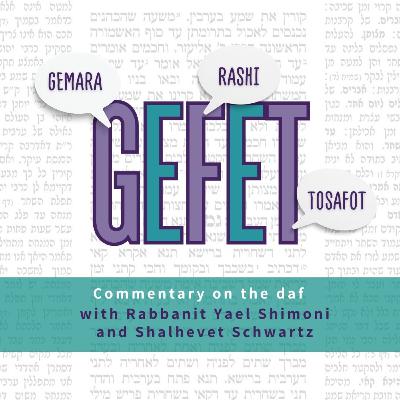Discover Beyond the Daf - Hadran
Beyond the Daf - Hadran

Beyond the Daf - Hadran
Author: Hadran: Advancing Talmud Study for Women
Subscribed: 10Played: 267Subscribe
Share
© Hadran: Advancing Talmud Study for Women
Description
Welcome to Hadran: Beyond the Daf where you will discover enlightening shiurim led by remarkable women, delving deep into the intricacies of Talmudic teachings, and exploring relevant and thought-provoking topics that arise from the Daf.
This podcast is more than just a study session; it's a platform dedicated to empowering women scholars, fostering diverse perspectives, and creating female Jewish role models. Tune in to be inspired, informed, and engaged in the vibrant world of Torah learning and discussions.
Daf Yomi shiurim podcast: Daf Yomi for Women - Hadran
hadran.org.il
This podcast is more than just a study session; it's a platform dedicated to empowering women scholars, fostering diverse perspectives, and creating female Jewish role models. Tune in to be inspired, informed, and engaged in the vibrant world of Torah learning and discussions.
Daf Yomi shiurim podcast: Daf Yomi for Women - Hadran
hadran.org.il
225 Episodes
Reverse
Gefet- Gemara, Perushim, and Tosafot, an in-depth Iyun gemara shiurIn the discussion about Aharon's aninut after the death of his sons, the Gemara addresses the status of Moshe Rabeinu, was Moshe also a Kohen? How does the story of Miriam’s Tzaraat help us understand Moshes' status? Which difficulty remains unanswered in Tosafot on the page? Have good answers to this question been found? Join us in studying the verses of the Torah through the lens of the sugya.Gefet Ep 201 Zevachim 102Gefet with Rabbanit Yael Shimoni and Shalhevet Schwartz is in collaboration with Yeshivat Drisha. Learn more on hadran.org.il
Din & Daf: Conceptual Analysis of Halakha Through Case Study with Dr. Elana Stein HainIn the very middle pesukim of the Torah, Moshe and Aharon argue over the laws of aninut, the period between the loss and the burial of a loved one: Moshe thinks Aharon and his sons should eat the korban hatat meat in the aftermath of the death of Nadav and Avihu, but Aharon disagrees and has already gone ahead and burned it. Aharon’s approach becomes our north star for the laws of aninut. But what is the character of aninut exactly? How does it differ from shiva, for example?Zevachim 101 Dr. Elana Stein Hain – dinanddaf@hadran.org.ilFor more Din and Daf: https://hadran.org.il/channel/din-daf/
Din & Daf: Conceptual Analysis of Halakha Through Case Study with Dr. Elana Stein HainThe eleventh chapter of Zevachim deals with cleaning up blood spatter from clothing and washing out or breaking vessels that have absorbed sacrificial material. This has to be done in the mikdash itself! Why? Is cleaning up a sacred act?Zevachim chapter 11Dr. Elana Stein Hain – dinanddaf@hadran.org.ilFor more Din and Daf: https://hadran.org.il/channel/din-daf/
Gefet- Gemara, Perushim, and Tosafot, an in-depth Iyun gemara shiurThe garments of the Kohen atone for many transgressions. What kind of atonement is this? Is it atonement without the sinner’s awareness? And if such atonement truly exists, how did we end up exiled from our land? after all, the garments of the Kohen were constantly atoning for all the most serious transgressions? This question stands in the background of our discussion this week. Join us for a further exploration of the concept of atonementGefet Ep 200Zevachim 88Gefet with Rabbanit Yael Shimoni and Shalhevet Schwartz is in collaboration with Yeshivat Drisha. Learn more on hadran.org.il
Zevachim 68On Second Thought: Delving Into the Sugya with Rabbanit Yafit ClymerLearn more on https://hadran.org.il/
Din & Daf: Conceptual Analysis of Halakha Through Case Study with Dr. Elana Stein HainThe Gemara mentions the concept of אין עניות במקום עשירות - there is no poverty in a place of wealth - in context of the Mikdash (Temple). This generally means that it is better to spend more money than to be thrifty when it comes to the Mikdash. This is is fascinating concept and raises questions about the value of spending - and also the value of saving - in Jewish life. What are its implications for Jewish life today?Zevachim 88Dr. Elana Stein Hain – dinanddaf@hadran.org.ilFor more Din and Daf: https://hadran.org.il/channel/din-daf/
Din & Daf: Conceptual Analysis of Halakha Through Case Study with Dr. Elana Stein HainIn the opening of the ninth perek (chapter) of Zevahim, we are introduced to the concept that even an invalid offering that is put on the altar, should be burned there rather than being removed. What is the logic behind this? Is the holiness of the altar somehow contagious, and it gets transferred even to an invalid sacrifice? What can we learn from this concept?Zevachim 83Dr. Elana Stein Hain – dinanddaf@hadran.org.ilFor more Din and Daf: https://hadran.org.il/channel/din-daf/
Gefet- Gemara, Perushim, and Tosafot, an in-depth Iyun gemara shiurThe Mishnah presents a dispute between Rabbi Shimon and the Sages regarding whether it is possible to reduce the permissible time for eating consecrated offerings. That is, when there is a mixture of two sacrifices—one that only priests may eat for a limited time, and another that non-priests may eat for a longer period—may one treat the shelamim as though it were an asham, thereby resolving the problem of the mixture? Rabbi Shimon rules that this is permissible, while the Sages disagree. What is the full scope of Rabbi Shimon’s position? Abaye proves in the Gemara that Rabbi Shimon spoke of such permission even lechatchila. The Rishonim disagree in explaining Abaye’s proof for Rabbi Shimon. Join us as we study and uncover this debate, which—surprisingly—turns out to hinge on a textual variant in the Mishnah in Ma’aser Sheni.Gefet Ep 199Zevachim 76 Gefet with Rabbanit Yael Shimoni and Shalhevet Schwartz is in collaboration with Yeshivat Drisha. Learn more on hadran.org.il
Din & Daf: Conceptual Analysis of Halakha Through Case Study with Dr. Elana Stein HainThe eighth chapter of Zevachim deals with when items that hold different statuses get mixed in with one another so that they become indistinguishable from each other. What happens then? The fact that the rabbis ask such questions speaks to their ability and interest in dealing with human fallibility. But what is the logic behind their prescriptions? Zevachim perek 8Dr. Elana Stein Hain – dinanddaf@hadran.org.ilFor more Din and Daf: https://hadran.org.il/channel/din-daf/
Din & Daf: Conceptual Analysis of Halakha Through Case Study with Dr. Elana Stein HainThe mishnah on Zevahim 66b discusses whether the sin of me’ilah - misappropriation of consecrated goods - applies to a korban hatat (sin offering) that has become invalid. This is an opportune time to discuss the trespass known as me’ilah. What does it entail? What religious ill does it represent?Zevachim 66bDr. Elana Stein Hain – dinanddaf@hadran.org.ilFor more Din and Daf: https://hadran.org.il/channel/din-daf/
How did we get from being vegetarians during the time of Adam and Eve to being meat eaters after the flood? And why? And how does this relate to sacrifices and the desire to eat meat?All this and more in the next episode.Zevachim 66On Second Thought: Delving Into the Sugya with Rabbanit Yafit Clymer Part two of a three part series: Three Spiritual Aspects of KorbanotLearn more on https://hadran.org.il/
Gefet- Gemara, Perushim, and Tosafot, an in-depth Iyun gemara shiurThe "mizbach haolah" is the copper altar that Moshe build in the wilderness -- a hollow altar that would, each time, be filled out with earth. Was this altar replaced by Shlomo? In the pesukim, it seems that it remained a copper altar, but Rashi and Tosafot both argue that the copper altar was hidden. How do Rashi and Tosafot explain the pesukim? And what is the position of Ralbag, who disagrees? Join us as we exlpore the mystery of the mizbach hanechoshet.Gefet Ep 198Zevachim 59-61 Gefet with Rabbanit Yael Shimoni and Shalhevet Schwartz is in collaboration with Yeshivat Drisha. Learn more on hadran.org.il
Din & Daf: Conceptual Analysis of Halakha Through Case Study with Dr. Elana Stein HainZevachim 60b discusses whether the original sanctification of Jerusalem still obtains without a Mikdash (temple). This parallels another debate among the rabbis as to whether the entire land of Israel is still considered sanctified even after two exiles. These discussions reveal what the source of the kedusha (sanctity) of Jerusalem and the land of Israel are - an important theological question!Zevachim 60bDr. Elana Stein Hain – dinanddaf@hadran.org.ilFor more Din and Daf: https://hadran.org.il/channel/din-daf/
Who deserves the honor for building the Beit Hamikdash? The builder or the planner? King Solomon? Or his father David? The Gemara has a fascinating answerZevachim 54On Second Thought: Delving Into the Sugya with Rabbanit Yafit ClymerLearn more on https://hadran.org.il/
Din & Daf: Conceptual Analysis of Halakha Through Case Study with Dr. Elana Stein HainThe korban chatat is clearly for accidental transgressions that would be worthy of the punishment of karet (excision) if one committed them purposely. But what is the korban asham for?Zevachim 54bDr. Elana Stein Hain – dinanddaf@hadran.org.ilFor more Din and Daf: https://hadran.org.il/channel/din-daf/
Din & Daf: Conceptual Analysis of Halakha Through Case Study with Dr. Elana Stein HainThe fifth chapter of Zevachim describes the precise way the korbanot were offered - with a focus on the use of the external altar - known alternatively as the מזבח הנחושת, the מזבח החיצון, or the מזבח העולה. In this shiur we offer a glimpse into the role of the altar in defining the character of the Mishkan/MikdashZevachim 47Dr. Elana Stein Hain – dinanddaf@hadran.org.ilFor more Din and Daf: https://hadran.org.il/channel/din-daf/
Gefet- Gemara, Perushim, and Tosafot, an in-depth Iyun gemara shiurThe Mishnah says that an idolater can bring korbanot The statement itself is fascinating, and from it emerges a debate in our sugya about the character and essence of Gentile korbanot. Join us as we explore, through this sugya, the nature of worship of God -- both for Jewish people and for the entire world.Gefet Ep 197Zevachim 45Gefet with Rabbanit Yael Shimoni and Shalhevet Schwartz is in collaboration with Yeshivat Drisha. Learn more on hadran.org.il
What is the Torah’s true attitude toward blood?On the one hand, the blood of the korbanot in the Beit Hamikdash is sprinkled upon the altar and brings atonement. On the other hand, the blood of animals and birds schechted outside the Beit Hamikdash must be covered.And what about the blood of Abel that cries out? The blood of the brit? “Do not stand idly by your neighbor’s blood”?All this and more in the next episode.Zevachim 31-37On Second Thought: Delving Into the Sugya with Rabbanit Yafit Clymer Part one of a three part series: Three Spiritual Aspects of KorbanotLearn more on https://hadran.org.il/
Gefet- Gemara, Perushim, and Tosafot, an in-depth Iyun gemara shiurWhat happens to the blood that is left over from chataot hapnimiyot? Join us as we delve into a debate among the Tannaim (and Rishonim) that will help us examine the role that these “leftovers” play.Gefet Ep 196Zevachim 39Gefet with Rabbanit Yael Shimoni and Shalhevet Schwartz is in collaboration with Yeshivat Drisha. Learn more on hadran.org.il
Din & Daf: Conceptual Analysis of Halakha Through Case Study with Dr. Elana Stein HainWhy are there 2 levels of korbanot - higher sanctity (kodshei kodashim) and lesser sanctity (kodashim kalim)? Zevachim 37a-b discusses the grouping of firstborn, tithed animal and Pesach offerings regarding the rituals related to their blood. But this grouping is indicative of a larger category within korbanot, namely קדשים קלים - the lesser sanctity korbanot. What distinguishes those korbanot from high sanctity korbanot קדשי קדשים?Zevachim 37a-bDr. Elana Stein Hain – dinanddaf@hadran.org.ilFor more Din and Daf: https://hadran.org.il/channel/din-daf/









